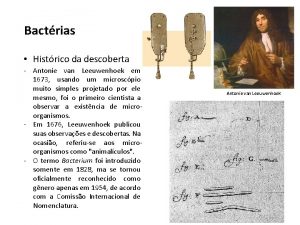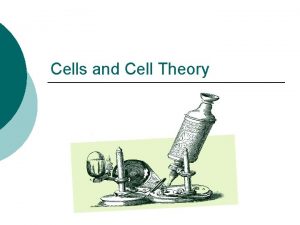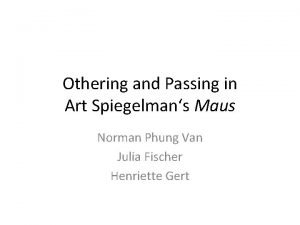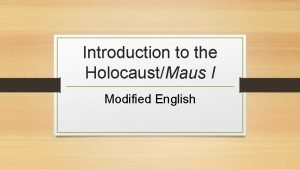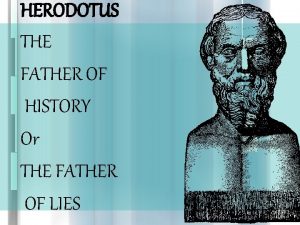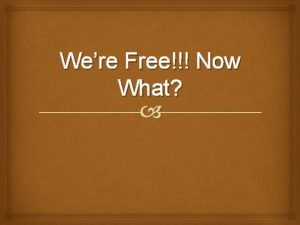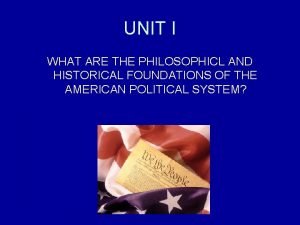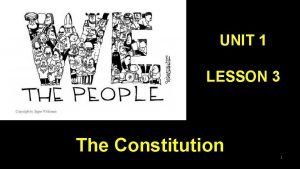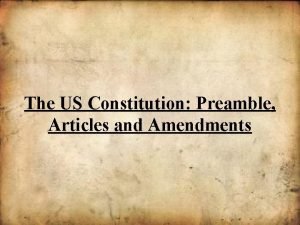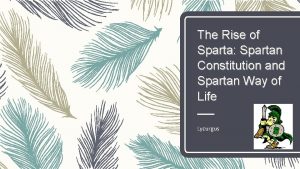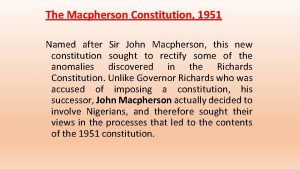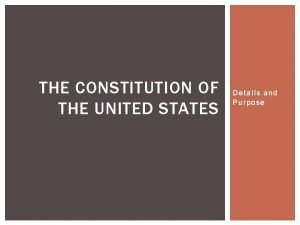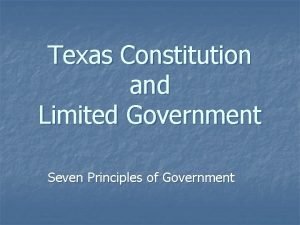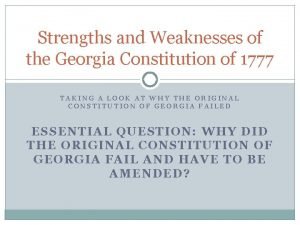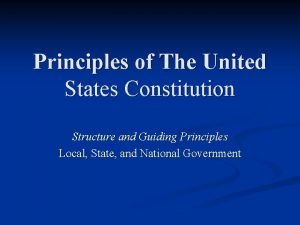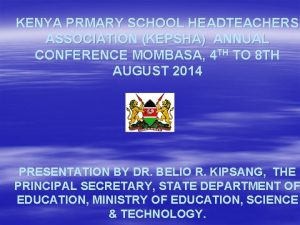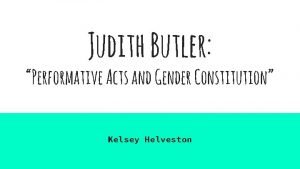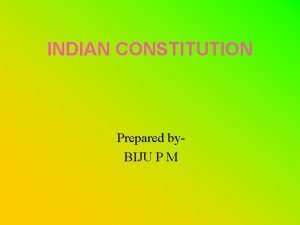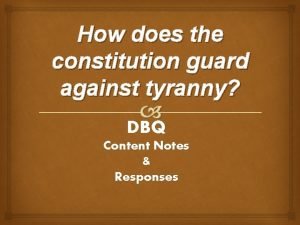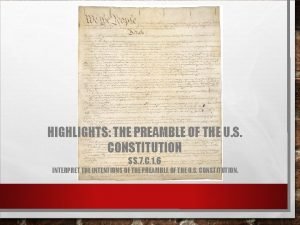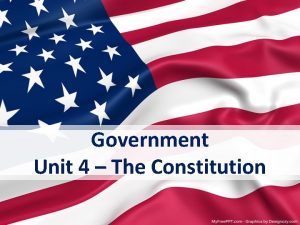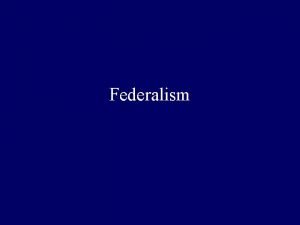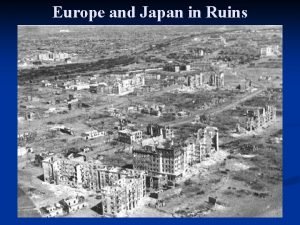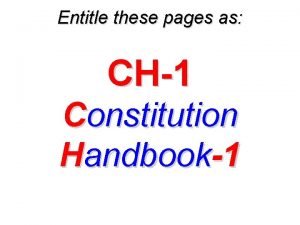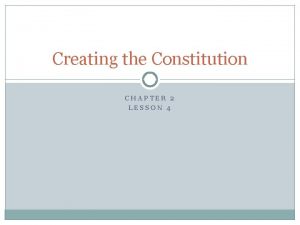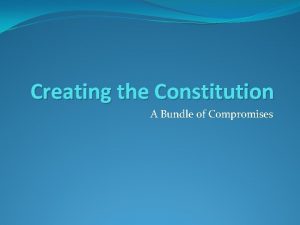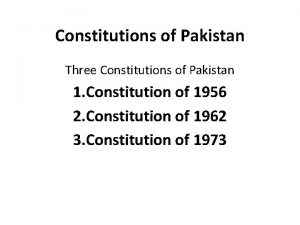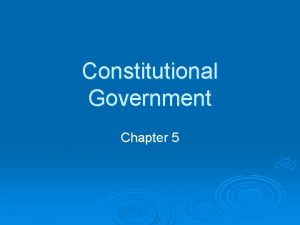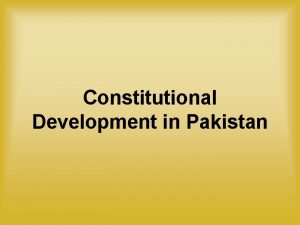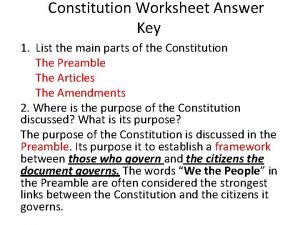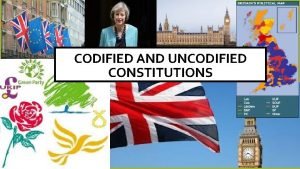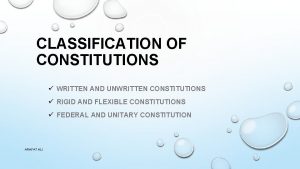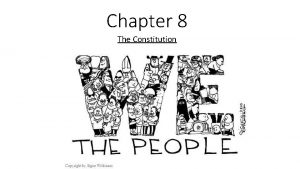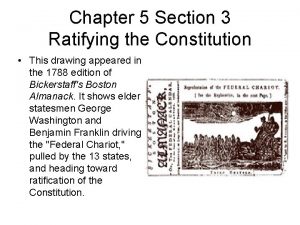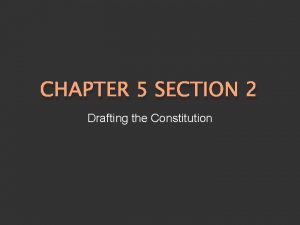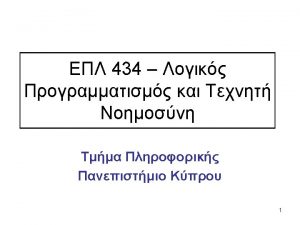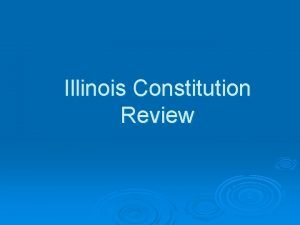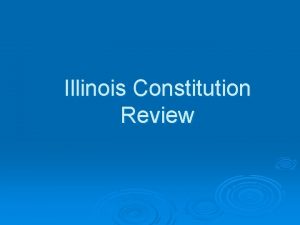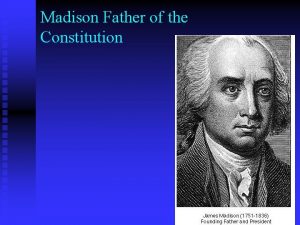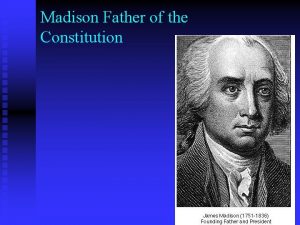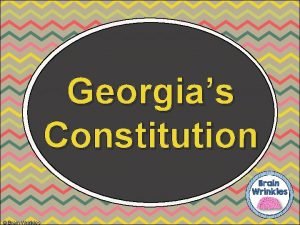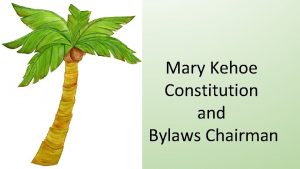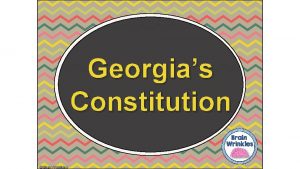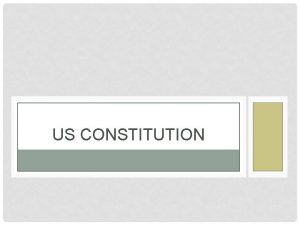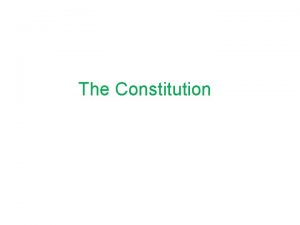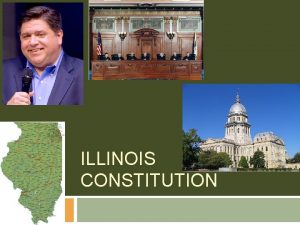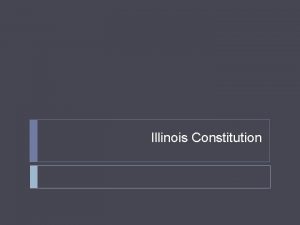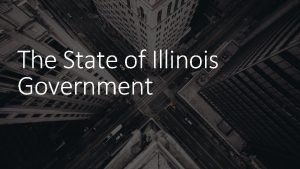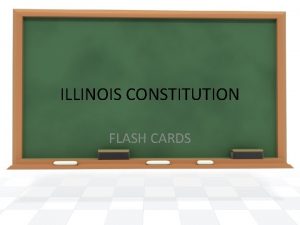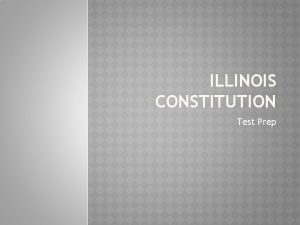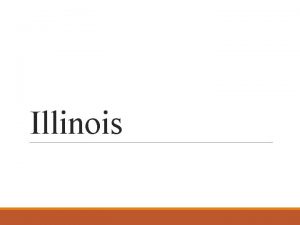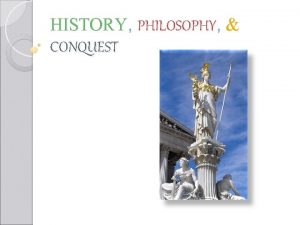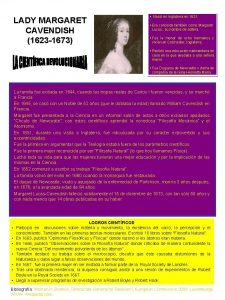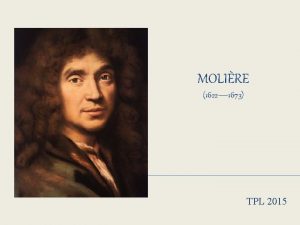Illinois Constitution History of Illinois In 1673 Father












































- Slides: 44

Illinois Constitution

History of Illinois • In 1673, Father Marquette and Louis Joliet explored the Illinois country. • In 1720, Fort de Chartres was built of palisades and the center of French colonial government in Illinois was established there. • In 1763, the French and Indian War ended. Illinois country ceded to Great Britain. • In 1778, George Rogers Clark and his American troops arrived to claim the Illinois country, which became a county of Virginia.

• In 1787, as part of the Northwest Territory, Illinois was to be surveyed and divided into townships, with land set aside for support of public schools. Slavery was abolished by law, but persisted in the region. • On December 3, 1818, Illinois became a state with Kaskaskia as the capital and about 40, 000 people. State Constitution let slaveholders retain slaves already in state but prohibited slaves from being brought into state. • In 1819, the state capital was relocated to Vandalia's centralized position on the National Road made it an important stagecoach stop. This road carried passengers and mail from Baltimore to St. Louis in only three weeks. • In 1970, the present Illinois Constitution was written.

Illinois Facts and State Symbols Illinois Facts • Capital City: Springfield • Nickname: Land of Lincoln / Prairie State • Motto: State Sovereignty, National Union. • Statehood: December 3, 1818 (21 st State) • The first state governor of Illinois was Shadrach Bond. • Origin of State's Name: The name “Illinois” comes from a Native American word meaning “tribe of superior men. ”

• Largest Cities: Chicago (nation’s 3 rd largest city), Aurora, Rockford, Joliet, Naperville, Springfield • Border States: Indiana, Iowa, Kentucky, Missouri, Wisconsin • Land Area: 57, 918 sq. mi. (24 th largest state) • Illinois' favorite son is Abraham Lincoln. The Lincoln sites in Springfield are among the best known tourist sites in the world. • The state's largest inland water system is Carlyle Lake, which covers 26, 000 acres in Southern Illinois. • Illinois ranks third in the nation in the number of interstate highway miles. • Illinois was the home of President Ulysses S. Grant, whose home is preserved in Galena.

State Symbols • State Tree: White Oak • State Flower: Violet • State Prairie Grass: Big Bluestem • State Mineral: Fluorite • State Bird: Cardinal • State Insect: Monarch Butterfly • State Fish: Bluegill

• State Animal: White-Tailed Deer • State Amphibian: Eastern Tiger Salamander • State Reptile: Painted Turtle • State Fossil: Tully Monster • State Soil: Drummer Silty Clay Loam • State Fruit: Goldrush Apple • State Snack Food: Popcorn • State Dance: Square Dance

• State Song: “Illinois”

Constitution Introduction and Preamble Introduction • In 1787, the United States Constitution set up a federal system of government giving some powers to the national government and other powers to the state and local governments. The U. S. Constitution told each state it must set up its own government and write its own constitution. States must have governments similar to the federal government, and the people of the state would elect their representatives. • Illinois became a state in 1818 and had to have its own constitution before it could become a state. The current Illinois Constitution, the sixth one, was adopted and ratified in 1970. • The Constitution has a short preamble and fourteen articles. The U. S. Constitution adds amendments at the end in a separate part, but when the Illinois Constitution makes amendments, the changes are made to the articles.

The Preamble • The Preamble to the Illinois Constitution is an introductory paragraph which explains why it was written. The preamble is shown below; some of the wording is similar to the preamble to the U. S. Constitution. • We, the People of the State of Illinois - grateful to Almighty God for the civil, political and religious liberty which He has permitted us to enjoy and seeking His blessing upon our endeavors - in order to provide for the health, safety and welfare of the people; maintain a representative and orderly government; eliminate poverty and inequality; assure legal, social and economic justice; provide opportunity for the fullest development of the individual; insure domestic tranquility; provide for the common defense and secure the blessings of freedom and liberty to ourselves and our posterity do ordain and establish this Constitution for the State of Illinois.

The Articles • The Illinois Constitution has 14 articles. Article I (1): The Bill of Rights • Article I guarantees freedom of religion, freedom of speech, the right to assemble and petition, the right to bear arms, freedom from self-incrimination, and the right to a trial by jury. • It also guarantees due process and equal protection which means everyone is entitled to the same basic rights and the same fair procedures under the law. • It forbids discrimination on the basis of sex and on the basis of physical or mental handicaps – a statement which is not found in the U. S. Constitution. • Eminent domain - allows the government to purchase private property for public use.

Article II (2): The Powers of the State • Article II of the Illinois Constitution divides the state government into 3 branches; the legislative, the executive, and the judicial. Article III (3): Suffrage and Elections Voting Qualifications • Article III sets up voting qualifications and election laws. To vote a person must be a U. S. citizen, 18 years old, and a resident of Illinois for at least 30 days prior to the election. Voters must register with the local election district at least 28 days before the election.

Voting Disqualification • A person convicted of a felony or who is otherwise under sentence in jail loses the right to vote. This right is restored after the sentence is served. Referendums • Voters are sometimes asked not only to vote for candidates, but also to vote on public issues such as bond issues of some governmental body or change in the state constitution. A tax increase for a school is settled by referendum.

General Election • An election involving all or most constituencies of a state or nation in the choice of candidates. • General elections are always held on the first Tuesday following the first Monday in November in even-numbered years.

Primaries • Primaries are elections in which party members elect the candidates of their party. Three ways of nominating candidates used are convention, caucus, and primaries. The primary is the most widely used method. • Closed primary: A primary election system in which voters can only vote for candidates from the party in which they are registered. • In a closed primary, voters on Election Day must choose one political party's ballot. Only Democratic candidates are found on the Democratic ballot. Republican candidates are found on the Republican ballot. Voters must choose only one ballot.

• Open primary: A primary election system in which voters can vote for candidates of any party, not simply the party in which they are registered. • In open primaries, voters receive the same ballot, which contains the candidates' names from all political parties. The voters do not have to declare their party affiliation in open primaries. • Illinois uses the closed primary system. • In the convention method, counties choose delegates to meet in a convention to decide a party's candidates. • In the caucus method, party leaders select political party candidates for the ballot.

Types of Ballots • Absentee ballot: When a person is away from their home (college, military service, vacation, business trip, etc. ), they may still vote using an absentee ballot. They must apply for the ballot in writing, vote, and return the ballot before the scheduled Election Day. • Straight ticket: Voting for all of the candidates in one party. • Split ticket: Picking and choosing candidates that you feel will do the best job without consideration of their party affiliation. • Incumbent: The person who currently holds the office.

Article IV (4): The Legislative Branch • Article IV provides rules for the legislative branch of the Illinois government, known as the General Assembly. Similar to the U. S. Congress, the General Assembly is divided into 2 houses, the Senate and the House of Representatives. • The General Assembly makes the laws for the state of Illinois. They meet each year on the second Wednesday of January. • Illinois is divided into 59 legislative districts. Each legislative district is divided into 2 representative districts. • Every ten years, the General Assembly must redistrict, or again divide the state into districts based on new census information. Districts must be “compact, contiguous, and substantially equal in population, ” which means districts can’t be divided into several parts and all districts must have approximately the same number of people.

• Each district elects one senator and two representatives, so there are 59 state senators and 118 representatives in the General Assembly. • To be elected to the General Assembly a person must be a U. S. citizen, at least 21 years old, and a resident of the district to be represented for at least 2 years. • Members of the General Assembly are elected every 2 years. • The term of a state senator is 4 years, and the term of a state representative is 2 years.

• Our State Senator is Paul Schimpf and he represents the 58 th District. • Our House District is the 116 th district and our State Representative is Jerry Costello Jr. • Illinois is also drawn into 18 Congressional Districts. • We live in the 12 th Congressional District, so our U. S. Representative is Mike Bost. • Our two U. S. Senators are Richard Durbin and Tammy Duckworth.

• Members of the General Assembly make laws for the state of Illinois. Each law begins as a bill, or proposed law, in either the Senate or the House of Representatives. • The bill must be passed by a majority of both the Senate and the House and then must be sent to the Governor within 30 days of its passing. • The Governor then has 60 days to sign the bill or veto it. If the Governor does not act within 60 days, it automatically becomes a law. • If the governor signs the bill, it becomes a law. If the governor vetoes the bill, it cannot become a law, unless the General Assembly overrides the governor’s veto. • To override the governor’s veto, three-fifths of the members of both the Senate and the House must vote in favor of the bill, and the bill becomes a law.

How Laws Are Made 1) A citizen, a group of citizens, or the legislators introduce a bill. 2) The bill is assigned to a committee to be written into legal language. 3) The bill now goes to the floor for consideration and begins with a complete reading of the bill. 4) Bill is sent to Committee. 5) The committee decides to pass the bill on to the next house, amend the bill, or pigeon hole the bill.

6) The bill goes to the consideration (2 nd reading). 7) Committee adds amendments. 8) The reading of the committee’s revisions. 9) Vote! 10) Finally, it is sent for presidential or gubernatorial consideration.

• Our state constitution puts the following restrictions on state lawmakers: they cannot hold any other public office in the state, they must file a statement of economic interests, and they cannot receive a salary increase during their term of office. • A lobby is an organized group who seeks to influence lawmakers. Impeachment • Impeachment means to bring charges against a government official. • In Illinois, the House of Representatives has sole power of impeachment, and the trial for impeachment occurs in the Senate. • There must be a quorum in order to impeach someone. A quorum means that a majority of the members must vote for impeachment.

Article V (5): The Executive Branch • The Executive Branch has six officials that are elected by the people of Illinois: Governor, Lieutenant Governor, Attorney General, Secretary of State, Comptroller, and Treasurer. • The Executive Branch enforces and administers the law. • To run for one of these offices a person must be a U. S. citizen, at least 25 years old, and a resident of Illinois for 3 years. Each official serves a four-year term.

Governor • The Governor is the chief executive officer of Illinois, just as the President is the chief executive officer of the United States. • One main duty of the governor is to see that laws passed by the General Assembly are carried out. • The Governor makes an annual report to the General Assembly, proposes a budget for the state, and signs or vetoes bills passed by the General Assembly. • State agencies such as the Illinois Department of Public Health, the Department of Children and Family Services, and the Department of Transportation carry out the laws and policies of the state. The Governor appoints the directors of these agencies and many other administrators. • The Governor nominates state officials, but the nominations must be approved by the state Senate.

• Many of the powers of the Governor are similar to the powers of the U. S. President. • One power the Governor has over the President is the ability to veto individual items of appropriation bills (bills which spend money). • The Governor can eliminate certain items from the bill and approve the rest of the bill. The President cannot do this; the President can only approve or veto the entire bill. Three Types of Vetoes • Regular veto - whole bill is rejected and returned to the house of the General Assembly where it began with a list of reasons why it was vetoed. • Item veto - only a part of an appropriation bill is vetoed. • Amendatory veto - specific recommendations noted and the house can pass the bill by simply accepting the recommendation.

• The Governor can also: - grant pardons, forgive a person for a crime. - grant reprieves, delay the carrying out of a criminal sentence. - grant commutations, shorten a criminal sentence. • The Governor of Illinois is J. B. Pritzker.

Lieutenant Governor • Similar to the Vice President of the United States. • Performs any duties assigned by the Governor. • If the Governor dies suddenly or is unable to serve, the Lieutenant Governor becomes Governor. The Lieutenant Governor is followed by the Attorney General and then the Secretary of State. • The Lieutenant Governor is Juliana Stratton.

Attorney General • Chief legal officer of Illinois. • Represents the state, state agencies, and state officials in court. • Chief law enforcement officer in Illinois. • Coordinates crime-fighting activities with state, county, and local authorities. • The Attorney General is Kwame Raoul.

Secretary of State • Keeper of the Great Seal of Illinois. • Keeps the official records of the General Assembly and the executive branch. • Licenses drivers and keeps drivers records, issues vehicle license plates and titles, and registers corporations. • This office has more direct contact with the people of Illinois than any other executive office. • The Secretary of State is Jesse White.

Comptroller • Chief fiscal control officer for Illinois. • Reviews all bills and payments, pays the state’s bills, keeps records, and helps set financial policies for the state. • The Comptroller is Susana A. Mendoza. Treasurer • Acts as the state’s banker, keeping and investing the money the state receives through taxes. • The Treasurer is Michael Frerichs.

Article VI (6): The Judicial Branch • The Judicial Branch administers justice, interprets the meaning of law and the Constitution of Illinois, and settles disputes. • There are 3 types of courts in Illinois - the Supreme Court, appellate courts, and circuit or trial courts - much like the federal court system. • The Illinois Supreme Court is made up of 7 judges called justices. • The Chief Justice is Lloyd Karmeier.

• The other six judges are Scott Neville, Robert Thomas, Thomas Kilbride, Rita Garman, Anne Burke, and Mary Jane Theis. • Supreme Court justices are elected by the people and serve a term of 10 years. • The Illinois Supreme Court hears appeals from the appellate courts and appeals from circuit courts when a death sentence has been imposed. • The Supreme Court has original jurisdiction in a few special types of trials.

• Appellate courts hear appeals from circuit courts. A total of 52 appellate court judges are elected. Appellate court judges also serve terms of 10 years. • Circuit courts hear most trials. Illinois is divided into 23 judicial circuits. Each circuit has a chief circuit judge, other circuit judges, and associate judges. • Currently there are 865 circuit and associate judges in Illinois. Circuit judges are elected and serve terms of 6 years. Associate judges are appointed by the circuit judges and serve terms of 4 years. • An Illinois judge must be a U. S. citizen, an attorney licensed to practice in Illinois, and a resident of the district or circuit.

Article VII (7): Local Government • This gives rules for local governments - for counties, townships, and cities. Local governments are given limited powers to pass ordinances, or local laws. Article VIII (8): Finance • This states that public money and property can only be used for public purposes, and how public funds are to budgeted, spent and audited. Article IX (9): Revenue • This describes how the state can collect money (revenue) from the people through taxes on property, income, and sales.

Article X (10): Education • This provides for free public education for all Illinois residents through high school. Article XI (11): Environment • This gives the General Assembly power to insure a healthy environment for Illinois residents. Article XII (12): Militia • This allows the General Assembly to form a state militia (military force) made up of Illinois citizens. The Governor acts as commander-in-chief of the state militia.

Article XIII (13): General Provisions • This gives several rules for persons running or holding office in Illinois. It also states that public transportation is an essential public service, one which the General Assembly can spend public money on. Article XIV (14): Constitutional Revision • This explains how the Illinois Constitution can be changed. Amendments to the Constitution may be proposed either by a Constitutional Convention or by the General Assembly. • If a Constitutional Convention is held to revise or amend the Constitution, a majority of Illinois voters must approve the changes. If the amendments are proposed by the General Assembly, the amendments must be approved by three-fifths of the voters at the next general election. • There have been 14 amendments to the Illinois Constitution.

Local Government Federalism • Our national system is based on federalism. Federalism is the sharing of the power of government amongst the federal, state, and local governments. The U. S. Constitution gives states the power to set up their own highway construction and maintenance systems, local laws, and education. Municipalities • A municipality (city, village, or town) is created upon the request of or with the consent of the residents in order that they may provide for themselves the services that they need or desire. • Some of these services are: fire and police protection, cultural and recreational facilities, water and sewer systems, street construction, traffic regulations, building and zoning regulation, and general health and welfare of the community.

Forms of Municipal Government 1. Mayor - Council Form: In the mayor and council form of government, the council and mayor are elected by the people. The council, however, is the legislative power and passes local laws. The mayor is the presiding officer of the council and he may vote in cases of a tie. He may veto measures from the council, but they can override his veto by a 2/3 vote. 2. Trustee Village: This type has 6 trustees and a village President. Valmeyer has this type of government. 3. Commission Form: This form has an elected mayor and 4 commissioners. The duties of city government are divided among these officers. 4. Council - Manager Form: The municipality may keep its structure as mayor/council, trustee village, or commission while adopting the manager form. A professionally trained manager is hired by the city to manage the municipality. 5. Strong Mayor Form: The mayor gets almost complete executive powers and the council is only legislative. As an example, the mayor does not need legislative approval of any of his appointments.

Counties • Illinois has 102 counties. The county is the largest unit of local government. Each county has a county seat where its governing body is located. Our county seat is Waterloo. • All counties carry out state policy in a general nature; they enforce laws, prosecute offenders, build and maintain roads, keep records, conduct elections, assess property, and collect taxes. Each county has a governing body known as the county board. Special Purpose Districts • For the purpose of providing special services for the people of Illinois, various special purpose districts have been formed. The public school district is an example of a special purpose district.

Illinois Boundaries • The Ohio River forms the southern boundary of Illinois. • The Mississippi River, known as "the Father of all the Rivers, ” forms Illinois’ western boundary. • Illinois’ eastern boundary is partially formed by the Wabash and Ohio Rivers.

Local Government Officials • Assessor – Oversees the appraisal and evaluation of all existing and newly constructed properties. • Circuit Clerk – Attend all sessions of court and maintains court docket and judgment records. • Coroner – Investigates and documents any and all sudden or violent deaths and performs autopsies when required. • Sheriff – Makes arrests and runs county jail.

• County Clerk – Records births and deaths and issues marriage licenses and oversees elections. • Treasurer – Oversees financial dealings and collector of real estate taxes. • County Commissioners – Prepares and adopts annual county budget and general administration of the county. • State’s Attorney – Prosecutes all actions, suits, indictments and prosecutions, both civil and criminal, in the circuit court. • Superintendent of Schools – Renews teaching certificates and distributes state funds to local districts.
 1673 anton van leeuwenhoek
1673 anton van leeuwenhoek 1673 cell theory
1673 cell theory Anton van leeuwenhoek 1673
Anton van leeuwenhoek 1673 Texas constitution vs us constitution
Texas constitution vs us constitution Nc constitution vs us constitution
Nc constitution vs us constitution Constitution what is constitution
Constitution what is constitution Lesson 1 principles of the constitution
Lesson 1 principles of the constitution My father bleeds history
My father bleeds history My father bleeds history
My father bleeds history What is the father of history
What is the father of history Also history physical
Also history physical Georgia constitution of 1777
Georgia constitution of 1777 Republicanism example
Republicanism example What was the 3/5 compromise
What was the 3/5 compromise Preamble of the constitution
Preamble of the constitution Constitution of sparta
Constitution of sparta Macpherson constitution
Macpherson constitution Seven articles of the constitution
Seven articles of the constitution Seven articles of the constitution
Seven articles of the constitution Texas constitution of 1876
Texas constitution of 1876 Georgia constitution of 1777 strengths and weaknesses
Georgia constitution of 1777 strengths and weaknesses 6 principles of the constitution
6 principles of the constitution Checks and balances in the constitution definition
Checks and balances in the constitution definition Kepsha
Kepsha Judith butler performative acts
Judith butler performative acts Why was shabnam happy that she had not watched tv
Why was shabnam happy that she had not watched tv How does separation of powers guard against tyranny
How does separation of powers guard against tyranny Dissecting the preamble
Dissecting the preamble Articles of confederation vs constitution
Articles of confederation vs constitution Georgia constitution
Georgia constitution Constitution supreme law of the land
Constitution supreme law of the land Note three ways war affected the land
Note three ways war affected the land Checks and balances in the constitution definition
Checks and balances in the constitution definition Chapter 2 lesson 4 creating the constitution
Chapter 2 lesson 4 creating the constitution The constitution a bundle of compromises
The constitution a bundle of compromises Three constitutions of pakistan
Three constitutions of pakistan What does the constitution do
What does the constitution do Salient feature of objective resolution
Salient feature of objective resolution Constitution worksheet answers
Constitution worksheet answers Uncodified constitution pros and cons
Uncodified constitution pros and cons Classification of constitutions
Classification of constitutions What does the constitution do
What does the constitution do Chapter 8 lesson 1 principles of the constitution
Chapter 8 lesson 1 principles of the constitution Chapter 5 section 3 ratifying the constitution answer key
Chapter 5 section 3 ratifying the constitution answer key Chapter 5 section 2 drafting the constitution
Chapter 5 section 2 drafting the constitution
